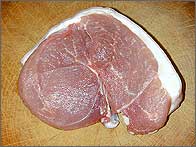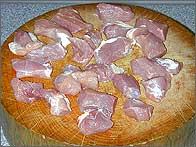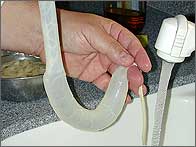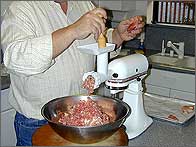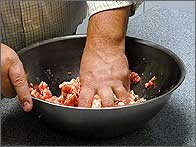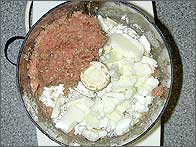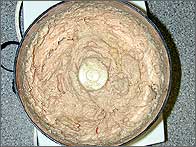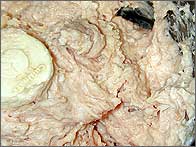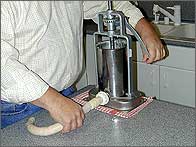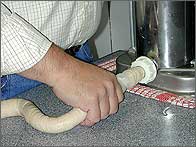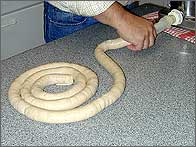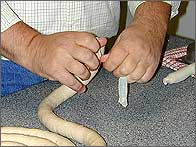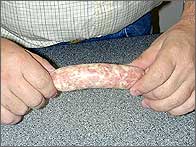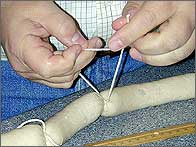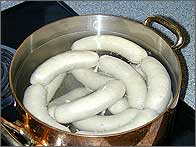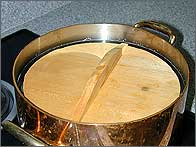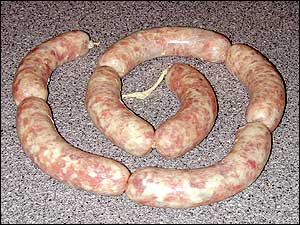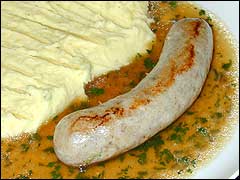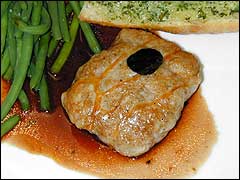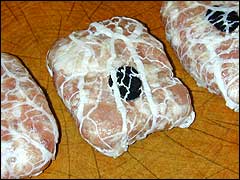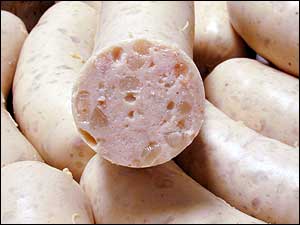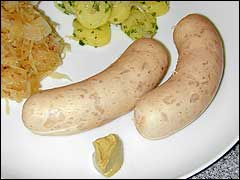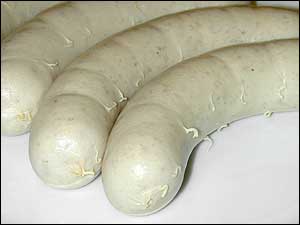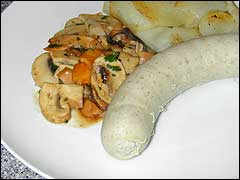
A visitor to France may notice a paradox — charcuteries sell a myriad of fresh and smoked sausages, but aside from the occasional cassoulet or choucroute garnie, sausages are not found on restaurant menus in an extensive variety, or often not at all. Aside from the occasional andouille served in a traditional Paris bistro, the saucisse de Francfort served hot in a baguette with cheese from a street-side takeout, or the saucisson sec served on a buttered baguette from a vendor at the train station, I haven’t found in my travels through France as many sausages available for eating in public as I have seen available at charcuteries and marchés. And for simple meals at home, what can be easier than simmering a boudin blanc or pan-frying saucisse de Toulouse?
In France where a wide variety of sausages can be obtained from any supermarché or local charcuterie, there isn’t much need for the home cook to make their own. People living outside of France who want French-style sausages have fewer options. One can attempt to duplicate the genuine article at home, but because sausage making requires specialized machinery and handling, the cook is usually limited in the scope of sausages that can be made at home. Smoked sausage and cured sausage are beyond the capabilities of someone (like myself) that lives in the middle of urban congestion, but fresh and poached sausages can easily be made with a little planning and practice. The recipes included with this article present the principles of preparing the latter types of sausage. (Click the hand to see the recipe.)
Cleanliness: Having clean hands, clean work surfaces, and clean equipment is always important when food is being handled or prepared, but it is even more important when preparing sausages. The meat and other ingredients are often handled multiple times and may not be cooked for several days so there is a greater chance of contamination than when preparing other food items.
Hands should be cleaned with anti-bacterial soap before handling any ingredients and re-cleaned multiple times during the preparation process. The same is true for work surfaces that come in contact with the sausage ingredients — they should be cleaned immediately prior to use and again immediately after use. Equipment should be sanitized before use each day and thoroughly cleaned immediately after use.
It’s quite easy to produce safe sausages in a home kitchen, but stringent rules of cleanliness must be followed.
Temperature: After cleanliness, strict observance of temperature guidelines is very important. Meat, especially fat, should be kept below 50 °F (10 °C) at all times while working with it, and it is preferred that the temperature of all meat products be less than 38 °F (3 °C) at all times. Grinders and food processors increase the heat of meat as they break it down, so when possible, meat should be partially frozen before grinding or chopping. In between processing steps, the ingredients should be refrigerated. Cooked ingredients should usually be cooled completely before adding to sausage meat mixtures.
Besides the safety aspect of keeping meat cool so that it doesn’t spoil, it’s important to keep it cool so the fat doesn’t melt. If the fat begins to melt during preparation, the texture and appearance of the finished sausage can be affected.
Meat: The primary meat used in sausage preparation is pork, although almost every other meat is used in specialty sausages of one type or another. The most common cut used for home production is the shoulder of the pig — sold in the United States as the “butt”. I often use the meat from the rear leg (above left) because it is leaner than the shoulder and I can control the lean–to–fat ratio easier in my home kitchen. Whichever is used, the meat should be cleaned of membranes, skin, nerves, and any discolored areas before use. It should be cut into pieces small enough to fit easily in the grinder and thoroughly chilled before grinding (above right). If the meat is to be cured before grinding, even smaller pieces are advisable.
Fat: Even though fat is an evil word in some circles, it is vital to sausage production. Sausages are generally between one–quarter and one–third fat. A non-fat sausage would have the texture, and probably the taste, of cardboard. Even non-pork specialty sausages often have pork fat added to prevent the sausage from being too dry. In some cases, such as seafood sausage, cream is used to provide the fat.
The best pork fat for sausage making comes from the back of the pig. This so-called hard fat melts less easily at low temperatures and produces a nicer texture than other pork fats. Other animal fats, especially poultry fats, tend to produce a grainy texture in the finished sausage.
The lean–to–fat ratio of the sausage meat mixture often must be adjusted from the recipe. The pork you use will be different from that of the recipe creator, so use the recipe as a guide. Make adjustments to the meat and fat quantities based on your own experience.
As with the meat, the fat should be cut into pieces small enough to fit easily in the grinder and thoroughly chilled before grinding.
Seasonings: Salt is the most common seasoning and curing agent found in home sausage making. Depending on the recipe, the salt may be added during final mixing or combined with the meat many hours in advance. Although long used as a preservative, the principal use of salt in home sausage making is for flavoring. In France, sausages usually contain about a quarter ounce of salt per pound (16 to 18 grams per kilo) of meat. Because of the lack of liquid to dissolve the salt, finely ground salt is preferable over coarse salt for sausages.
Sausage recipes often call for curing agents, such as saltpeter. Besides inhibiting botulism, these additives also help maintain the rosy color of sausages. Saltpeter (potassium nitrate) is not as readily available as it used to be and is now usually replaced by sodium nitrate. Sodium nitrate is a toxic substance and its use in a pure form is forbidden in France. In France it is available blended with common salt in a ratio of 99.4% salt and 0.6% sodium nitrate. In the United States, curing salt is available from butcher supply stores with a similar composition. In France, the allowable amount of curing salt is about one–sixth of an ounce per pound (15 to 20 grams per kilo) of meat. When preparing a recipe that calls for saltpeter, substitute curing salt and adjust the amount of salt and curing salt required based on the above ratios. Curing salts are usually added to the meat a number of hours in advance of grinding. When producing sausages at home that will be eaten fresh or cooked immediately, the curing salts can be left out, but a rosy color will most likely not be achieved in the final product. Sausages that are to be dried or smoked should always be cured first, but these sausages are beyond the scope of this article.
Other seasonings are added to the sausage in the amounts and quality called for in the recipe. Herbs are usually used in a dry form for ease in handling and measuring. Aromatic additives such as onions, garlic, and shallots are cooked first to mellow their flavors and then cooled before adding to the meat.
Casings: Most meat mixtures are packaged in casings in order to achieve the traditional sausage shape. The most common casings available for home use are medium (32 to 35 mm diameter) hog casings and small (20 to 22 mm diameter) sheep casings. The casings are sold by butcher supply stores and some specialty meat stores. They are sold packed in salt and last many years if refrigerated in the salt.
Before use, the casings are soaked in cold water for 30 minutes or so and flushed with a couple of passes of cold water (as shown above).
Grinding: Meat and fat can be ground in either a hand or power grinder. Because the process of grinding will heat the meat and fat, they should be partially frozen before grinding. The temperature of the meat and fat must not exceed 50 °F (10 °C) during grinding. If you are grinding a large quantity of meat, work in batches to maintain a cool temperature. Be sure the grinder is at room temperature or lower before use.
Grinders have plates with various size holes that determine how fine or coarse the resulting ground material will be. The most common size holes used in home sausage making are 1/8" (3 mm), 1/4" (6 mm), and 3/8" (9 mm). For recipes that refer only to fine, medium, or coarse, use 1/8" for fine, 1/4" for medium, and 3/8" for coarse. When meat is to be finely ground, it is sometimes easier to first coarsely grind the meat and then pass it though the fine plate on a second pass. When changing plates to grind different materials, clean out the grinder thoroughly between uses.
The grinder should be immediately cleaned before and after use.
Mixing: For mixtures that will not be chopped, it is necessary to mix the lean and fat meats and, if not already added, the seasonings. This can be accomplished either by hand or with a stand mixer using a paddle attachment. For small quantities of forcemeat, I’ve found that hand mixing does a better job than machine mixing with less clean-up required. Your hands need to be thoroughly washed before mixing, or clean food–service gloves can be used.
Chopping: Some preparations call for the sausage mixture to be finely chopped, or emulsified (above center and right). For the home cook, a food processor must substitute for the horizontal or vertical chopper used by the professionals. Food processors can quickly heat a batch of sausage meat so it is important to chill the meat close to 32 °F (0 °C) and work in small batches. Additionally, the bowl and blade of the food processor should be chilled in a refrigerator before using. Liquids to be added during the chopping can be partially frozen before adding to the processor (above left) before chopping.
Stuffing: Because the sausage meat mixture should be chilled as cold as possible before stuffing, 35 °F (1 to 2 °C), it is difficult to stuff casings using the old-fashion funnel and plunger method. Some mechanical stuffer is required. Some grinders have sausage stuffing attachments that can be used for occasional projects. Small commercial stuffers are available from restaurant supply stores at a reasonable price.
No matter what type of stuffer is used, it is important to be sure to pack the meat mixture into the stuffer without creating air pockets. Air pockets result in air bubbles in the finished sausage. Use the largest stuffing tube that works with the casing being used so that the meat mixture is not heated by forcing it through too small of a tube. Sufficient casing is slipped onto the stuffing tube and a knot tied in the end before the stuffing starts. Push the mixture into the casings at a steady rate so that the sausages are even in shape and texture. Don’t fill the casing too tight — leave some room for expansion during cooking.
Dividing: After stuffing the casing, tie a knot at the end of the filled casing (above left) and “massage” the entire length of the sausage to even out the forcemeat. Create individual sausages by twisting off individual links (above middle) or by tying with kitchen string (above right).
Inspect the surface of the individual sausages and puncture a small hole with a very sharp skewer over any air bubbles. Some recipes call for evenly puncturing the entire surface of the casing. Always make the puncture holes as small as possible so that not too much fat is exuded during cooking.
Drying: In commercial operations, the sausages that contain curing salt are usually air cured before cooking. This involves hanging the sausages in a ventilated cabinet that has both temperature and humidity controls. Air drying is usually performed at 85 to 120 °F (30 to 50 °C) depending on the product being dried. Since this step is not usually possible at home, it is left out. The result is that the color of the meat is not as intense as it should be and the casing may not be as transparent.
Cooking: Many sausage recipes call for poaching the sausage as a last step. Some recipes call for preheating the water before adding the sausages and some call for adding the sausage to cold water (above left). My preference is the latter method. The poaching water should be heated rapidly to 175 to 185 °F (80 to 85 °C). A drop lid will help keep the sausage below the level of the water (above right). I poach my sausages to 160 °F (71 °C), but to fully coagulate the proteins and destroy any bacteria, the sausage should reach 175 °F (80 °C). At this high of a temperature there is greater weight loss and shrinkage. If clean methods of preparation have been followed, the lower temperature should pose no problems.
Onion skins or artificial food coloring can be added to the poaching water to color the sausage casings. Sometimes, a strong bouillon is used for this purpose.
Immediately following cooking, rapidly cool the sausages in an ice bath to stop carryover cooking. The rapid cooling causes the newly–cooked sausages to quickly pass through the temperature zone of 77 to 112 °F (25 to 45 °C) where most dangerous microbes grow.
Storage: When completed, the sausages should be air dried in the refrigerator for a couple of hours. In commercial operations the sausages are hung in the refrigerator to get better air movement around the sausages. At home, this is usually not possible so the sausages should be placed on racks for the drying process.
The completed sausages should either be refrigerated until used, or frozen. When refrigerated, most fresh sausages will last a day or two and poached sausages a few days longer. If frozen, the sausages should be tightly wrapped to prevent drying out. If possible, it is best to eat the sausages fresh since some changes in flavor and texture occur during freezing.
Further reading: There are a number of books available that discuss sausage making and provide recipes. I found that when I started making sausages, it was helpful to consult many books. The following is a brief list of some of these books.
• M Cottenceau, J-F Deport, J-P Odeau (translated by A Sterling), The Professional Charcuterie Series, Volume I. CICEM (Paris) and Van Nostrand Reinhold (New York). 1991.
• J-C Frentz, M Poulain (translated by A Sterling), Charcuterie Specialties. CICEM (Paris) and John Wiley & Sons (New York). 1996.
• R Kutas, Great Sausage Recipes and Meat Curing. The Sausage Maker Inc. (Buffalo NY). No date.
• B Aidells, D Kelly, Hot Links and Country Flavors. Alfred A Knoff (New York). 1990
• V Wise, American Charcuterie. Penguin Books (New York). 1986.
• J Predika, The Sausage-Making Cookbook. Stackpole Books (Harrisburg PA). 1983.
Conclusion: Sausage making can seem to be a daunting task for the home cook, and indeed there are many sausages that would be difficult to do without a major investment in equipment and facilities. The results obtainable with minimal equipment and effort, however, can produce simple sausages that are well worth the time and money.
©2001, 2014 Peter Hertzmann. All rights reserved.

©2001, 2014 Peter Hertzmann. All rights reserved.

